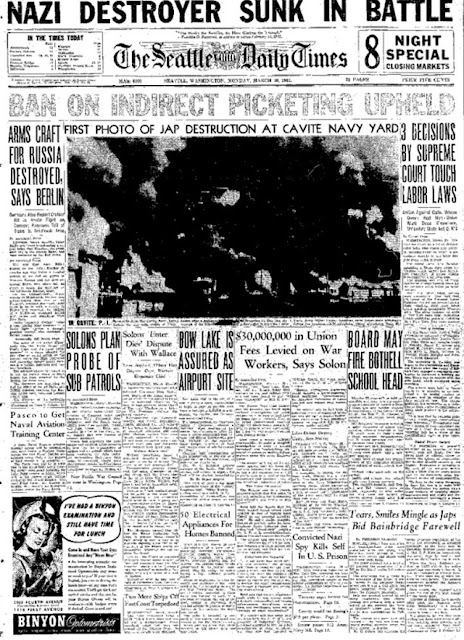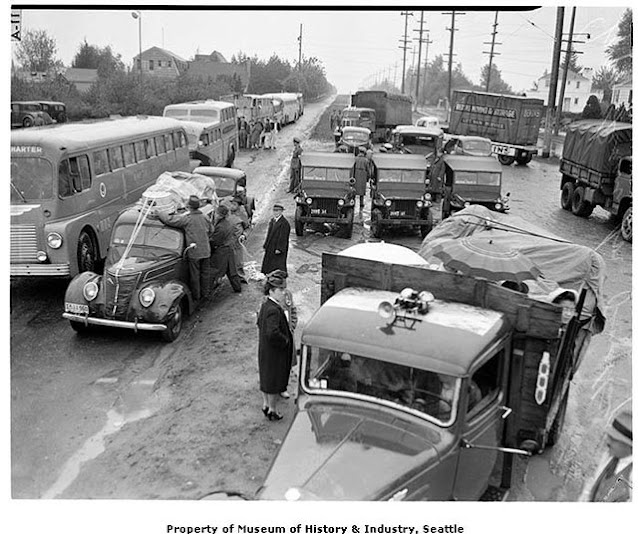Monday 30 March 1942
 |
| Japanese carrier force Kido Butai on its way into the Indian Ocean on 30 March 1942. In the line are Akagi, Soryu, Hiryu, Hiel, Kirishima, Haruna, Kongo, and Zuikaku. |
Battle of the Pacific: As 30 March 1942 begins, the Japanese 55th Division is pushing the Chinese back at Toungoo, Burma. The Chinese 200th Division abandons Toungoo by 04:00 after a bitter battle, retiring in good order to the east. Later in the morning, the Japanese attack in force all along the line, seizing the bridge across the Sittang at 07:00 and breaking into the Chinese line at 08:50. The Japanese then occupy Toungoo from the east against light resistance.
The Japanese success at Toungoo creates a gap in the Allied lines that the Chinese now must try to fill. The Chinese 22nd Division advances from the north and has some success at the Nangyun train station. This threatens the Japanese rear as they advance east from Toungoo. The two Chinese divisions then meet at Yedashe north of Toungoo on the east bank of the Sittang east of Nangyun. This helps to create a new defensive line to the east of Toungoo that slows the Japanese advance along the Sittang River Valley.
A Japanese force sails toward Christmas Island, south of Java, with 900 troops. There are rich phosphate deposits on the island
US Navy submarine USS Sturgeon torpedoes and sinks Japanese freighter Choyo Maru in the Makassar Strait.
 |
| The Daily News, 30 March 1942, headlines attacks in Japan, but the main photo is of the blizzard in Maryland. |
Eastern Front: Having pocketed Gogland Island during the Battle of Suursaari, the three Finnish battalions in the area send a patrol to investigate nearby Bolshoy Tyuters. A determined Soviet garrison on the island repels the patrol, and the Finns make plans to return in force in a couple of days. This begins a short but sharp fight for the relatively insignificant island.
General Seydlitz, in charge of the relief force heading toward the Demyansk pocket, bows to the inevitable and informs his superior, General Kuechler, that he must stop the attack and regroup. He decides to shift his main axis of advance north to the main Staraya Rusa - Demyansk road. While more resistance can be expected there, going through the woods in the midst of the spring thaw (Rasputitsa) simply is not feasible. The Soviets, meanwhile, are rushing reinforcements to the area.
European Air Operations: RAF Bomber Command sends 34 Halifax bombers to attack the German battleship Tirpitz in a fjord near Trondheim. The ship is well hidden and the bombers do not locate it. This is one of many unsuccessful raids on the battleship that the British launch over the course of several years. Three bombers do bomb nearby Flak positions. There is one Halifax bomber lost in this raid.
 |
| Seattle Daily Times, 30 March 1942, headlines a German destroyer sunk in the Arctic (Z26) and some labor decisions at the US Supreme Court. |
Battle of the Atlantic: The after-effects of the fierce German attacks on Convoy PQ-13 continue to reverberate in the Barents Sea. The weather is terrible, adding to the misery of anyone unlucky enough to wind up in the water.
U-585 (Kptlt. Ernst-Bernward Lohse), which has been operating against Convoy PQ-13 in the Barents Sea, is presumed to have hit a German defensive from field Bantos A that drifted loose mine and sunk on or about 30 March 1942. Nobody from the submarine, 44 men, is ever found. U-585 ends its career with no victories in four patrols.
U-435 (Kptlt. Siegfried Strelow), on its second patrol out of Trondheim, finds a straggler from Convoy PQ-13 and sinks it. The ship is 6421-ton US freighter Effingham, which was abandoned because it already had been attacked by U-456 (Kptlt. Max-Martin Teichert). There are 31 survivors and a dozen dead, with many of the deceased having survived the torpedoes but passed away in the lifeboats from exposure due to brutal weather conditions.
 |
| British freighter Induna, sunk by U-376 on 30 March 1942. |
U-376 (Kptlt. Friedrich-Karl Marks), on its first patrol out of Helgoland, gets its first victory when its crew spots 5087-ton British freighter Induna. The ship is a straggler from Convoy PQ-13 due to bad weather, and U-376 puts one of three torpedoes into it northeast of the Kola Inlet. Another submarine, U-209, had been chasing Induna but U-376 happened to be in its path, so both subs witness the sinking. There are 38 dead and 22 survivors. The tale of the Induna is unique because it is the ship of the convoy's vice commodore, and he had collected a total of six stragglers and formed a new mini-convoy. The Induna was carrying survivors from another sunken ship, Panamanian freighter Ballot. Eleven of the 16 men picked up from the Ballot perish in this second sinking.
U-68 (KrvKpt. Karl-Friedrich Merten), on its third patrol out of Lorient, torpedoes and sinks 5853-ton British freighter Muncaster Castle. The submarine hits the freighter, which is part of Convoy ST-18, with two torpedoes at 22:43 south of Monrovia. The ship is carrying 268 passengers, and they take to more than ten lifeboats. There are 329 survivors (passengers and crew) and only 24 deaths.
German raider Thor shells and sinks 4649-ton British freighter Wellpark about 500 miles southwest of St. Helena in the South Atlantic. There are seven deaths.
 |
| Japanese-Americans being removed from Bainbridge Island, Washington, on 30 March 1942. This is an assembly point where internees are to be taken to the Puyallup Assembly Center pursuant to Civilian Exclusion Order No. 1. The 227 residents subject to the order have had six days' notice. The 49 residents not on the island on 30 March 1942 are not allowed to return. The internees ultimately wind up at the Manzanar War Relocation Center in California (Seattle Post-Intelligencer, courtesy of the Museum of History and Industry). |
Battle of the Mediterranean: King George VI sends Malta an official message:
I have been watching with admiration the stout-hearted resistance of all in Malta – Service personnel and civilians alike – to the fierce and constant air attacks of the enemy in recent. Weeks.
In active defense of the Island the Royal Air Force has been ably supported by R.M.A. [Royal Malta Artillery], and it, therefore, gives me special pleasure, in recognition of their skill and resolution, to assume Colonel in Chief of Regiment. Please convey my best wishes to all ranks of my new regiment, and assure them of the added pride with which I shall follow future activities.
This is a great honor for the Royal Malta Artillery.
Inter-American Relations: Today is the first meeting of the Inter-American Defense Board in Washington, D.C. Its purpose is to study plans for the defense of the hemisphere.
Inter-Allied Relations: The Pacific War Council is established in Washington, D.C. At this time, it includes representatives of the U.S. (technically President Roosevelt, but Harry Hopkins handles this for him), the U.K., China, Australia, New Zealand, the Netherlands, and Canada. Representatives of India and the Philippines are added later.
US Military: Having gained complete control of the Pacific Theater of Operations from the British on 24 March 1942, the US Joint Chiefs of Staff organize it into three sectors: the Pacific Ocean Areas (POA), the South West Pacific Area (SWPA) and the Southeast Pacific Area. The POA contains the smaller islands and atolls on the direct route from the United States to Japan, while the SWPA is centered at Australia and covers the Philippines, New Guinea, the Bismarck Archipelago, the Solomons, and most of the Netherlands East Indies.
While not formally decided at this point, General Douglas MacArthur will have control of the SWPA and Admiral Chester Nimitz will lead the POA, the two most important areas in terms of combat. The Southeast Pacific Area technically has been in existence since the Pearl Harbor attack and currently is under the command of Rear Admiral John F. Shafroth Jr.
 |
| Life Magazine, 30 March 1942. Featured on the cover is actress Shirley Temple. |
Australian Military: Five Kittyhawk Mk. Ia fighters (P-40Es) arrive at Seven Mile Aerodrome at Port Moresby. These reinforce the RAAF No. 75 Squadron and suggest that the Allies are going to fight hard to keep Port Moresby.
Spain: A Swordfish of RAF No. 801 Squadron lands in Spanish Morocco due to mechanical issues. Defying the common stereotype that Spain is solidly in the Axis camp, it interns the crew accordingly to international law and eventually returns them to the British at Gibraltar - which it is under no obligation to do.
American Homefront: Today is the date mandated for all residents of Japanese ancestry to be off Bainbridge Island, Washington. This is the first such exclusion order that is fully realized. Many Filipino farmers/laborers on the island are not subject to the exclusion order and stay to work the fields previously worked by the Japanese-Americans. This leads to the creation of the Indo-Pino (or Indipino) community there due to intermarriage between residents of Filipino extraction and members of the First Nations tribes of British Columbia.
Many items such as new private automobiles already have ceased production due to government orders. Today, small electric appliances such as electric razors (still new in 1942) and toasters are prohibited from production. Retailers can still sell stocks on hand.
Spain: A Swordfish of RAF No. 801 Squadron lands in Spanish Morocco due to mechanical issues. Defying the common stereotype that Spain is solidly in the Axis camp, it interns the crew accordingly to international law and eventually returns them to the British at Gibraltar - which it is under no obligation to do.
American Homefront: Today is the date mandated for all residents of Japanese ancestry to be off Bainbridge Island, Washington. This is the first such exclusion order that is fully realized. Many Filipino farmers/laborers on the island are not subject to the exclusion order and stay to work the fields previously worked by the Japanese-Americans. This leads to the creation of the Indo-Pino (or Indipino) community there due to intermarriage between residents of Filipino extraction and members of the First Nations tribes of British Columbia.
Many items such as new private automobiles already have ceased production due to government orders. Today, small electric appliances such as electric razors (still new in 1942) and toasters are prohibited from production. Retailers can still sell stocks on hand.
March 1942
March 1, 1942: Second Battle of Java Sea
March 2, 1942: Huge Allied Shipping Losses at Java
March 3, 1942: Japan Raids Western Australia
March 4, 1942: Second Raid On Hawaii
March 5, 1942: Japan Takes Batavia
March 6, 1942: Churchill Assaults Free Speech
March 7, 1942: British Defeat in Burma
March 8, 1942: Rangoon Falls to Japan
March 9, 1942: Japanese Conquest of Dutch East Indies
March 10, 1942:US Navy attacks Japanese Landings at Lae
March 11, 1942: Warren Buffett's First Stock Trade
March 12, 1942: Japan Takes Java
March 13, 1942: Soviets Attack In Crimea Again
March 14, 1942: The US Leans Toward Europe
March 15, 1942: Operation Raubtier Begins
March 16, 1942: General MacArthur Gets His Ride
March 17, 1942: MacArthur Arrives in Australia
March 18, 1942: Japan Attacks In Burma
March 19, 1942: Soviets Encircled on the Volkhov
March 20, 1942: "I Shall Return," Says MacArthur
March 21, 1942: Germans Attack Toward Demyansk
March 22, 1942: Second Battle of Sirte
March 23, 1942: Hitler's Insecurity Builds
March 24, 1942: Bataan Bombarded
March 25, 1942: Chinese Under Pressure in Burma
March 26, 1942: Win Or Die, Vows MacArthur
March 27, 1942: The Battle of Suusari
March 28, 1942: The St. Nazaire Commando Raid
March 29, 1942: The Free Republic of Nias
March 30, 1942: Japanese-Americans Off Bainbridge Island
March 31, 1942: Japanese Seize Christmas Island
2020


No comments:
Post a Comment